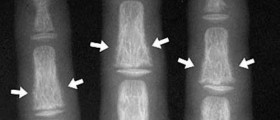The problem called elevated alkaline phosphatase is associated with the range of the alkaline phosphatase, which is exceeded or elevated. The body has an enzyme called alkaline phosphatase and it is mostly located in the bones and liver. Kidneys, placenta and intestinal lining have this enzyme also, but in smaller amounts. When we say elevated level of alkaline phosphatase, we think of the level over 140 IU/L, while normal range is between 20 and 140 IU/l.

The proper functioning of the liver and the bile flow to the small intestine is greatly dependent on the normal alkaline phosphatase level. Infants would have a level from 50 to 165 U/l, while children have a normal level ranging from 20 to 150 U/l. Level from 20 to 70U/L is considered normal, while normal level for adults older than 60 goes from 30 to 75 U/L. Liver problems can be detected if the elevated level of alkaline phosphatase is present, since the liver is the greatest manufacturer of this enzyme. Due to this, the change in the level of this enzyme may suggest liver problems.
Causes of Elevated Alkaline Phosphatase
The measurement of the alkaline phosphatase level and detecting the cause of this can be done with an alkaline phosphatase test. Levels can be raised due to the obstruction or congestion of the biliary tract and some liver conditions, like livery tumor, fatty liver, cirrhosis, cholangitis, cholecystitis and hepatitis. Another possible cause is the gallbladder dysfunction.
p>Bone alkalinity is very important since it is responsible for the formation of the cells named osteoblasts and buildup of calcium. If the level has been elevated, this may suggest rheumatoid arthritis, osteomalacia, osteoporosis, rickets injury, shingles and Paget’s disease. But elevated level of alkaline phosphates is common for women who are pregnant, and children.
Tests and Enzymes Used for the Determination of a Problem
When a person comes to the hospital complaining of the problem associated with the elevated alkaline phosphates, there is a test that is done and that can diagnose this problem. It uses a blood sample and examines the level of calcium in the blood. There are several symptoms associated with this condition, but the most common are joint pain, bone pain, dark urine, nausea, jaundice, fatigue and weakness. Problems like bone cancers, damaged liver cells, and other problems can be detected with the help of this test.
There are several reasons why the level of alkaline phosphatase is lower than normal, and the most common are excess intake of vitamin D, folic deficiency, vitamin C deficiency, hypothyroidism and zinc deficiency. In order to have a proper treatment, see a doctor who will find the cause and treat it.
In the most widely used international method, p-nitrophenol phosphate serves as the substrate, while an amino alcohol is used as a buffer. The rate of release of p-nitrophenol phosphate from the substrate is measurable as a marker of alkaline phosphatase activity and results are reported in international units per liter (IU/L). The different methods appear equally effective in the detection of abnormal values in various clinical diseases. Using multiples of the upper limit of normal is a simple way of comparing results obtained via different tests.
- Electrophoresis does not reliably differentiate the isoenzymes as the electrophoretic mobility of bone and liver isoenzymes is only slightly different. Electrophoresis on cellulose acetate, with the addition of heat inactivation, is a much reliable test than electrophoresis alone. Polyacrylamide gel slab-based separation provides accurate identification of the liver, bone, intestinal and placental isoenzymes; this test is, however, not widely available.
- Patients with blood group O and B may need to fast before the test to avoid contribution from the intestinal isoenzyme if there is an unexplained elevation of alkaline phosphatase on routine tests. The phlebotomist uses a gold-top serum separator tube containing a clot activator and serum gel separator to collect the blood for analysis.
- There are many potential analytic sources of error. Factors such as concentrations of phosphate, magnesium, citrate, type, and concentration of buffer maintenance of the correct temperature may affect the result.
- When alkaline phosphatase is the only liver biochemical test that presents as elevated (i.e., when the serum aminotransferases are within normal limits), or when alkaline phosphatase is disproportionately elevated compared to other liver biochemical tests, evaluation of the patient should focus on identifying the cause and the source for the isolated or disproportionate alkaline phosphatase elevation. In asymptomatic patients with isolated elevation of serum alkaline phosphatase, it is essential to identify the primary source of abnormality.
- Alkaline phosphatase derived from the liver, bone, placenta, and intestines have different physicochemical properties. There are three general methods that have shown to be particularly used for discriminating between isoenzymes: thermostability studies; differential inhibition with various small peptides, amino acids, and other low molecular weight substances; and immunologic methods.

















Your thoughts on this
Loading...